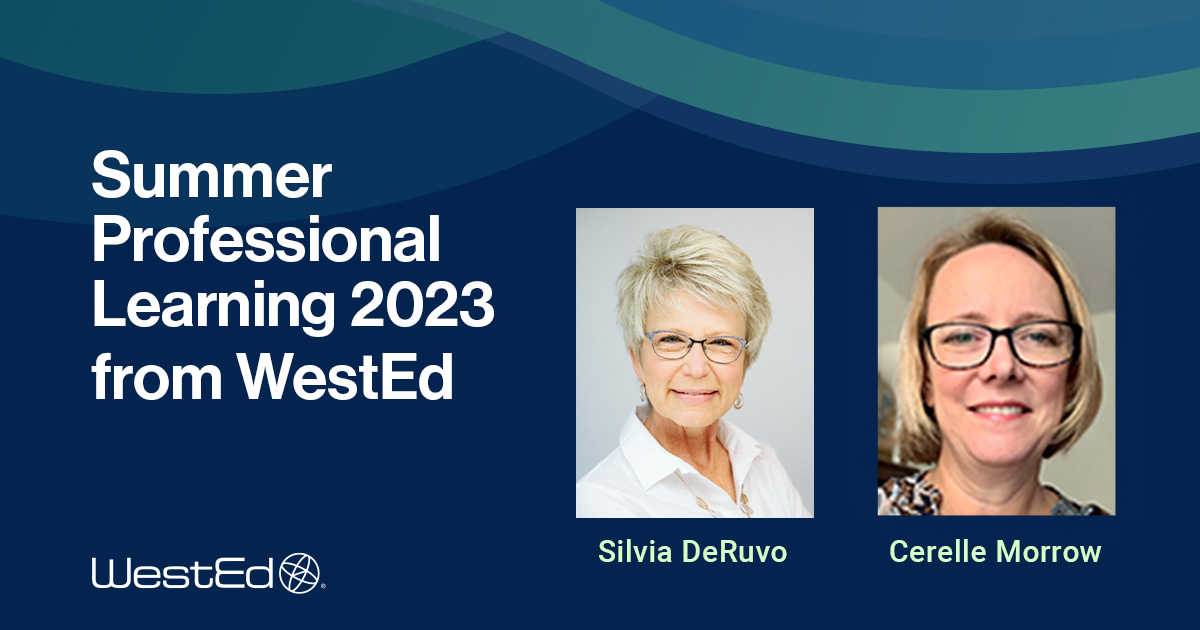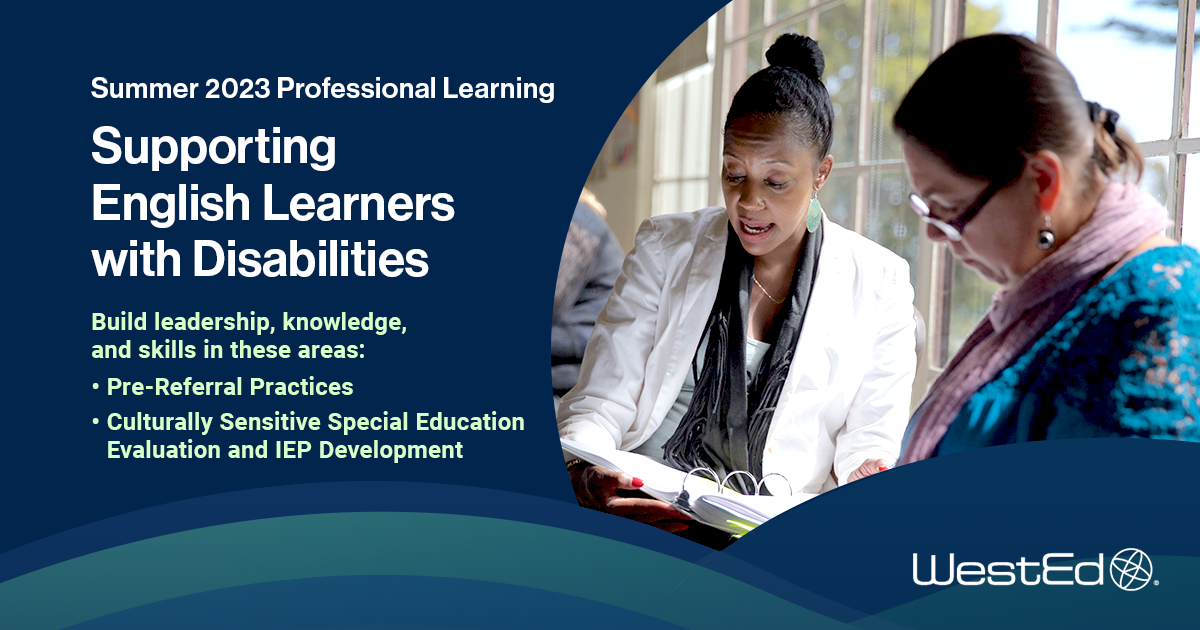Summer Learning: Supporting English Learners at the Intersection of Language Learning and Disability
Posted on

As classrooms in the United States become more diverse, educators are developing ways to better support teaching and learning for every student, including English Learners who may or may not have disabilities.
WestEd is offering two virtual institutes this summer to help practitioners support English Learners who may or may not have a disability. The institutes will provide practical instructional strategies and delve into the systemic processes needed to meet students at the intersection of language learning and disability.
In this Q&A, WestEd facilitators Silvia DeRuvo and Cerelle Morrow discuss the upcoming institutes, learning acceleration, and equitable education for English Learners with disabilities.
Throughout her 30-year career, DeRuvo has been dedicated to promoting equity in education for students with disabilities and struggling learners. Morrow collaborates with schools and districts to design and implement professional learning for English Learners, English Learners with disabilities (ELSWD), and others.
Q: What inspires your work to support ELSWD?
DeRuvo: I was an English Learner, as my family immigrated to the United States as refugees from Europe in the late 1950s. I was born here, but only German was spoken in our home. Our strong and rich culture permeated all areas of our lives. My parents were not literate in English, so their understanding of the education system and their ability to support us was restricted. Because our culture wasn’t celebrated in school, I never wanted my students to feel they couldn’t celebrate who they were and the culture they brought. My goal was to both support their English language development and meet their specific learning needs related to their disability.
Morrow: As a former ESL middle school teacher in a large urban school district, I was often struck by the number of English Learners in my classes who were unable to exit EL services, even after being in the United States for so many years. What caused their lack of progress? Why weren’t they reclassified? Why were so many identified for special education services? At WestEd, I often heard other ESL teachers asking these same questions. I was thrilled by the opportunity to work with our special education group to research and design professional learning around the topic. Though we are still struggling with these questions, I hope our work will help educators better understand how to improve learning environments, school structures, and instruction to better support these students.
Q: How does this professional learning support education equity?
DeRuvo: Ensuring that English Learners with disabilities have equitable access to all the supports and services they are entitled to is our work’s purpose. English Learners and students with disabilities have been marginalized in schools, and providing services that meet students’ needs where disability and language learning intersect has often reduced their access to grade-level core content instruction.
Morrow: These institutes will help educators ensure that English Learners with suspected disabilities are being offered quality opportunities to learn. This includes examining targeted resources for ELs suspected of having a disability and clarifying “best practices” in the identification and appropriate pre-referral processes. This professional learning will also help educators make sense of the roles that language, disability, and schooling systems play in creating inequitable learning environments and how to frame our thinking with an asset orientation.
Q: Are the institutes geared toward supporting learning recovery and acceleration?
DeRuvo: When we talk about pre-referral strategies, we focus on acceleration, not remediation. The goal of culturally and linguistically responsive interventions is to accelerate student skills to reduce gaps so students have greater access to the grade-level curriculum. We build upon our philosophy that recognizes the need for learning recovery and acceleration by including English Learners identified as having a disability in a literacy-rich general education classroom and receiving integrated language development in the content instruction, general education interventions, direct English language development (ELD), and special education supports.
Q: Who will benefit from participating in the institutes?
DeRuvo: The institutes are designed to equip new and veteran general education teachers, ELD specialists, interventionists, special educators, and related services providers to recognize and honor the dual learning needs of this unique group of students. We endeavor to provide teams with new skills, perspectives, and practices that will inform grade-level classroom instruction, intervention practices, and processes for special education evaluation, IEP development, and instruction for dually identified students.
Morrow: This professional learning is designed for all English Learner educators who want to better identify whether an English Learner is struggling with language or has a disability. ESL teachers and specialists might find the information in both sessions helpful as they grapple with students not making the progress they should. Both ESL and Special Education specialists will find session two helpful in identifying data that should be collected during the pre-referral process and how to develop a linguistically and culturally relevant IEP.
Q: How unique is this professional development compared to other offerings?
DeRuvo: This work uniquely addresses evidence-based practices in pre-referral instruction and intervention by focusing on Culturally Responsive Design for English Learners: The UDL Approach within a multitiered system of support for English Learners framework, designed on the model demonstration research sponsored by the Office of Special Education Programs of the U.S. Department of Education. These approaches focus not just on instructional strategies but on the systems needed to meet students at the intersection of language learning and disability.
Q: What is an educator’s most significant challenge in identifying whether a student struggles with language acquisition or a disability?
DeRuvo: It is usually determining if behaviors that English Learners exhibit are related to language acquisition or a possible disability, which often look very similar. Without access to grade-level instruction, appropriate intervention, and direct ELD instruction, it is very difficult to determine the causes of the behaviors. The professional development in the institutes promotes processes and practices that address EL learning challenges so that only after extensive data has been collected could a team determine that a referral for special education evaluation is appropriate.
Morrow: The question “Is it language or disability?” is frequently asked about an English Learner with a suspected disability. According to Kangas (2021), educators should also look closely at the systemic disadvantages in our school systems and shift away from this deficit orientation of identification. The intersectionality of language and disability may make answering this question impossible. A closer examination of learning environments and school structures, including the quality of instruction, will tell us more about the student and their learning needs.
Q: What does a culturally sensitive Individualized Education Program look like, and what does creating one entail?
DeRuvo: A culturally sensitive IEP recognizes both English Learners’ language development and their learning needs. It considers a student’s assets, strengths, interests, and culture as well as special education and ELD programming and services. It moves away from a deficit-based approach by honoring a student’s home language when providing instructional supports to meet IEP goals and recognizing that both language and disability are assets.

